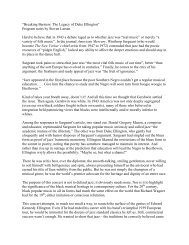JOHN ADAMS The Chairman Dances (Foxtrot for Orchestra) John ...
JOHN ADAMS The Chairman Dances (Foxtrot for Orchestra) John ...
JOHN ADAMS The Chairman Dances (Foxtrot for Orchestra) John ...
You also want an ePaper? Increase the reach of your titles
YUMPU automatically turns print PDFs into web optimized ePapers that Google loves.
of Hartman’s work was put together in St. Petersburg, where it opened in<br />
mid-February 1874. <strong>The</strong> show included both architectural plans and diverse<br />
drawings and paintings with scenes of everyday life and different human types.<br />
Sometime in the first month after it opened, Mussorgsky visited the exhibition.<br />
It had a powerful effect on him. On June 12 or 19 (the date is not certain) he<br />
wrote to Stasov with good news: “Hartman is boiling as Boris boiled.” This<br />
was his way to say that he was deeply involved in composition and that it was<br />
going well. Clearly he had already discussed a Hartman project with Stasov,<br />
since he offered no other explanation. But he continued: “Sounds and ideas<br />
have been hanging in the air; I am devouring them and stuffing myself—I<br />
barely have time to scribble them on paper…My profile can be seen in the<br />
interludes….How well it is working out.”<br />
In that view, he was certainly right. Composing at a terrific pace, Mussorgsky<br />
finished the work by June 22—fast work indeed <strong>for</strong> so elaborate a score. <strong>The</strong><br />
suite was immediately hailed by the composer’s friends, particularly Stasov, to<br />
whom the composer dedicated the piece, since he had organized the Hartman<br />
exhibition that was its inspiration. While his friends admired it enormously,<br />
few people played the suite; it is fiendishly difficult. Pictures was not even<br />
published until five years after the composer’s death. It only became famous<br />
and popular in the brilliant orchestral guise created by Maurice Ravel in 1922 at<br />
the suggestion of conductor Serge Koussevitzky.<br />
<strong>The</strong> various “pictures” are linked here and there by references to the opening<br />
Promenade, which, as Mussorgsky reported, was his own self portrait; he<br />
imagined himself “roving through the exhibition, now leisurely, now briskly in<br />
order to come close to a picture that had attracted his attention, and at times<br />
sadly, thinking of his departed friend.” He labeled it as being “in the Russian<br />
style,” which is immediately evident.<br />
<strong>The</strong> music representing each image is so vivid that no explanation is required,<br />
though the listener might care to know something about the original pictures<br />
(fewer than half survive today, but we have Stasov’s description of the<br />
exhibition to tell us about the others).<br />
<strong>The</strong> Gnome was a grotesque drawing <strong>for</strong> a child’s toy. As Stasov said, “It is<br />
something in the style of the fabled Nutcracker, the nuts being inserted into<br />
the gnome’s mouth. <strong>The</strong> gnome accompanies his droll movements with savage<br />
shrieks.” [Promenade] <strong>The</strong> Old Castle depicted a landscape of markedly<br />
Italianate cast with a troubadour singing his lay. In Ravel’s version there is<br />
an extended solo <strong>for</strong> saxophone, one of the most famous passages <strong>for</strong> that<br />
instrument in the orchestral repertory. [Promenade] Tuileries, a Parisian<br />
scene, showed children quarreling at play in the famous gardens, an image<br />
perfectly captured in the taunting musical figure (the universal children’s cry of<br />
“Nyah, nyah!”) that begins the scene and returns again and again throughout.<br />
Bydlo is the Polish word <strong>for</strong> “cattle”; Hartman’s picture showed a heavy ox cart<br />
lumbering along. [Promenade] <strong>The</strong> unlikely sounding Ballet of unhatched<br />
chicks consisted of designs <strong>for</strong> an 1871 ballet entitled Trilby (not related in<br />
any way to George du Maurier’s sensationally popular novel of 1893) with<br />
choreography by Petipa and music by Gerber. Petipa always included a scene<br />
with child dancers. In this case the children were dressed as canaries “enclosed<br />
in eggs as in suits of armor, with canary heads put on like helmets.”<br />
Samuel Goldenberg and Schmuyle: Mussorgsky himself owned Hartman’s<br />
drawings of “A rich Jew wearing a fur hat” and “A poor Jew: Sandomierz.” He<br />
transmuted these into a single movement contrasting the arrogance of wealth<br />
to the cringing obsequiousness of poverty (Mussorgsky himself evidently<br />
invented the names given to the two personalities). [Promenade] Hartman’s<br />
lively drawing of <strong>The</strong> Market at Limoges becomes a brilliant scherzo, <strong>for</strong><br />
which he even imagined some of the conversation of the shopping housewives,<br />
<strong>for</strong> he entered bits of their dialogue in the margin of the score: “Great news!<br />
M. de Puissangeout has just recovered his cow…Mme. de Remboursac has just



